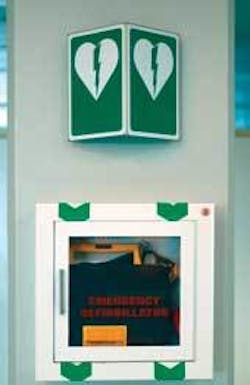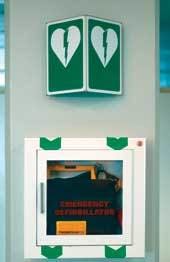AEDs in dental offices
Practical considerations and risk-management strategies for the dental practitioner
by Richard A. Lazar
In many ways, dental practitioners are risk-management professionals. Besides delivering dental services, dentists are asked to identify risks and implement safety solutions designed to reduce office-related fatalities and injuries. One emerging risk associated with the dental office is sudden cardiac arrest (SCA).
SCA strikes approximately 350,000 Americans annually - about 1,000 victims per day or the equivalent of three full 747 aircrafts. It is a leading cause of adult death in the U.S. Most people who experience SCA have not been identified as high risk, and approximately 20 percent of SCA victims have never been diagnosed with any type of heart disease. Approximately 10 percent of SCA events occur in people younger than 40. Predicting who, when, and where SCA will strike is virtually impossible. The vast majority of SCA events occur outside of hospital settings, and the overall SCA survival rate in the U.S. is estimated to be less than 5 percent.
Defibrillation
The only effective emergency treatment for SCA is defibrillation, which is the rapid delivery of an electric pulse (shock) to the heart using an automated external defibrillator (AED). Survival rates for SCA victims can exceed 90 percent if defibrillation occurs in the first one to two minutes, but declines by about seven to 10 percent per minute for every minute thereafter. After eight to 10 minutes, the survival probability is near zero.
Dental practices are seeing an increasing number of elderly and medically compromised patients. In addition, dentists often administer local and general anesthesia. From a population and treatment perspective, dental offices are places where sudden cardiac arrest is reasonably likely to occur. An emerging question is whether dental offices should have AEDs.
Response challenges associated with AED programs
To effectively treat sudden cardiac arrest, AEDs must be used within four to five minutes. From an operational and AED response system engineering perspective, the following actions must occur quickly if this response time objective is to be achieved:
- A potential SCA event must be quickly recognized by a bystander
- A call to 911 must be promptly initiated
- A bystander must know or be informed that an AED is located nearby and its precise location identified, and
- An AED must be rapidly retrieved and used.
Dental office professionals responsible for AED programs are obligated to deploy these lifesaving devices in a well-structured emergency response operational environment. There are significant risks associated with poorly designed AED programs that can lead to victims dying at locations that possess AEDs. Consider the following examples:
- A scientist visiting a prominent medical institution in Maryland died from SCA within 20 feet of an easily accessible AED. Staff members were apparently unaware of the presence of the device.
- Efforts to defibrillate an SCA victim who collapsed at the Philadelphia International Airport were unsuccessful after two retrieved AEDs failed to operate, likely due to dead batteries.
- A 12-year-old girl collapsed and died from SCA while visiting a Texas water park. The family sued claiming the park failed to retrieve and use an available AED.
- An Arizona college student died from SCA after collapsing on the athletic field. An AED was retrieved but failed to operate, likely due to a dead battery.
- A Texas high school student died from SCA within 50 feet of an available AED. The device was locked in a field house and no one present had a key.
- A 24-year-old woman died from SCA while on a cruise ship. The family sued claiming a 30-minute delay in retrieving an available AED.
Unfortunately, there are an increasing number of SCA deaths arguably resulting from AED program design failures. These examples reinforce the need for dental office professionals to carefully consider how AEDs are deployed, and the design and function of the AED program infrastructure surrounding the devices.
Strategies to help save lives
Successful dental office AED programs must ensure that operational AEDs can be rapidly retrieved when needed. Many elements must be considered and implemented for this objective to be achieved. While numerous factors should be considered, following are key elements that should be included in all dental office AED programs:
- Proper number of AEDs in the right locations: Each office should deploy a sufficient number of AEDs so that one can be retrieved and used within four to five minutes.
- Visible and widely known AED placement locations: AEDs should be placed in known locations that are accessible to everyone. Situations involving locked, “invisible,” or otherwise inaccessible AEDs should be avoided. Inform everyone in the office of the locations of AEDs and place AED signs in proximity to each device. All employees and office visitors should know what AEDs are for and that they are easy to use.
- Proper AED inspection and maintenance: AEDs are easy to maintain; however, each AED should be inspected at least monthly and serviced if needed. Batteries and electrodes that are within 90 days of expiring should be replaced.
- Sufficient number of AED responders: AEDs are safe and easy to operate by formally trained as well as untrained users. While a core group of office staff should receive formal training in AEDs, everyone in the office should be permitted to use them. This approach is supported by the easy-to-use nature of AEDs and the fact that the devices are designed to deliver a shock only to those who need it - if an AED does not detect the right type of abnormal heart rhythm, it will not deliver a shock. Using an AED cannot worsen an SCA victim’s condition.
- Adequate AED response communications: Make sure that office staff members are able to rapidly communicate the need for an AED and the SCA victim’s location so that an AED can be quickly retrieved.
If implemented properly, these strategies increase the chances an AED will be available, ready for use, and retrieved when needed. This increases the chances SCA victims will survive.
Strategies to help manage risks
AED program risk management strategies fall into four categories:
Liability insurance: As with any safety program, dentists should carry liability insurance of the right types and with the right coverage limits to adequately protect against reasonably foreseeable claims. Staff should check with their insurance brokers to confirm that coverage for emergency medical response activities is included. Appropriate coverage should be added if necessary.
Good Samaritan immunity protection: Each state and the District of Columbia have Good Samaritan immunity laws specifically applicable to AED-related activities. Unfortunately, these laws vary widely and do not protect everyone.
Many state AED immunity laws contain conditions that must be met in order for AED users to qualify for protection. The following are examples of administrative and operational conditions found in AED Good Samaritan laws:
- AED maintenance
- Training
- Physician supervision
- Agency notification
- Program documentation
To clearly understand whether, to what degree, and on what conditions AED Good Samaritan immunity coverage may help protect your AED program, review applicable state and local laws. If necessary, consult with your attorney and/or risk manager to ensure legal and operational requirements are clearly defined.
AED manufacturer’s indemnification: Some AED manufacturers offer liability indemnification coverage as a component of AED program services. This adds another layer of liability protection. When considering such programs, it is important to have your legal and risk management professionals review carefully the terms of indemnification to ensure that all aspects of AED program operations are protected.
Carefully designed and operated AED program: Perhaps the best strategy for managing risk is to ensure that your AED program is reasonably designed and operated. While not all lives will be saved, by identifying and configuring key characteristics necessary for a reasonable AED program, you can effectively and defensibly prepare for and respond to sudden cardiac arrest emergencies prior to the arrival of traditional emergency medical services resources. This proactive risk management approach is most likely to reduce the threat of lawsuits associated with sudden cardiac arrest events in your office.
Structuring your AED program
AED programs represent an important component of overall office safety. Your AED program should be structured to:
- Ensure that the AED program recognizes and meets the intent of applicable laws and regulations in each state in which the organization operates
- Meet reasonable life-saving response time goals within the context of properly balanced program costs, benefits, and risks
- Encourage prompt lifesaving action, and
- Ensure the program is “reasonable” and well documented.
By their very nature, AED programs are established in an effort to quickly deliver treatment to victims of sudden cardiac arrest. While AED programs can improve the chances of survival, they cannot guarantee survival. Clearly, dental office AED program sites are not hospital emergency departments, and the people who volunteer to help SCA victims are generally not trained emergency health-care professionals. As a result, even well designed AED programs will not function as designed every time they are needed.
Your AED program should recognize the nature of the environment and include reasonable program elements that will increase chances of success. Success, however, cannot be assured. When success happens and lives are saved, the value of your AED program pays dividends to all affected.Richard A. Lazar, the nation’s leading authority in AED program operations, risk management, law and public policy, is president and CEO of AED Risk Insights, Inc. AED Risk Insights, www.AEDRiskInsights.com, is the nation’s leading provider of AED risk management, legal information, and public policy advocacy services. Lazar can be contacted at [email protected].
Why dental offices may deploy AEDs
There are three reasons why dentists may choose to buy and deploy AEDs:
Voluntary choice: For various reasons, many dental professionals are voluntarily purchasing AEDs for their offices. This decision may be based on a growing awareness of the benefits of having AEDs, knowledge of a life saved with an AED, or the death of someone who might have survived had an AED been nearby.
Coerced voluntary choice: Another reason AEDs are appearing in dental offices is the perception that a “standard of care” may require the presence of these lifesaving devices in the medical office setting. The concept of a “standard of care” relates to a community’s expectations when gauging an organization’s conduct towards another as expressed through trial judges, juries, and appellate courts considering negligence lawsuits.
To date, no legal cases have been found accusing a dentist of negligence for failing to have an AED. Such cases appear inevitable given the dental community’s widely publicized knowledge of the benefits of AED therapy and the nature of dental office patients. In 2002, the ADA Council on Scientific Affairs published a recommendation that most dentists consider AEDs in their offices. Successful lawsuits have been brought against airlines, health clubs, theme parks, and other entities for failing to have AEDs. Similar lawsuits seem certain to emerge against dentists.
Statutory/regulatory mandate: Statutes and regulations can impose requirements on dentists and create a mandatory standard of care. Florida represents the best example of this approach on the AED issue. Section 64B5-17.015 of the Florida Administrative Code states:
“As part of the minimum standard of care, every dental office location shall be required to have an automatic external defibrillator by Feb. 28, 2006. Any dentist practicing after Feb. 28, 2006, without an automatic external defibrillator on site shall be considered to be practicing below the minimum standard of care.”
In addition, many states require that AEDs be placed in dental offices in which patients receive deep sedation or general anesthesia. Because these states have established AEDs as a standard of care, the failure to have an AED creates a significant liability risk.

